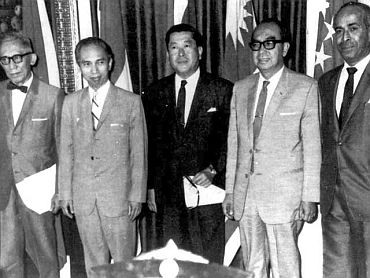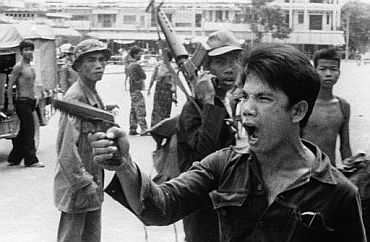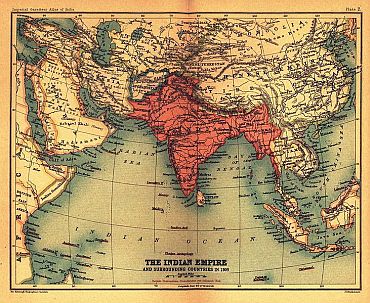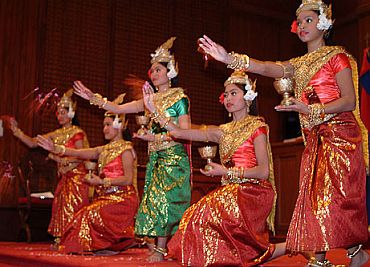Colonel Anil A Athale (retired)
In part one of this series (How India can build a ring of steel around China) Colonel Anil A Athale (retired) outlined the contours of the coming Sino-Indian conflict in South East Asia.
In this the second and final part, he examines the geopolitics of the regions and explains ways in which India and step into the power vacuum that exists there.
Brief review of the geo-politics of South East Asia
Except in the heyday of Non-Aligned Movement in early 1960s, when India had a larger than life political profile, South East Asia has seldom been on political radar of Indian establishment.
In the Bandung Summit of 1955, the then Prime Minister Jawaharlal Nehru played a major role and there was much talk of Afro-Asian solidarity. This laid the foundations of the NAM.
Leaders like Ho-Chi-Minh of Vietnam, Prince Norodom Sinhanouk of Cambodia, were all present. This was an attempt of newly independent nations in Asia and Africa to steer away from Cold War tensions. Chou En Lie of China made his first major debut on the international scene.
...
How India can negate Chinese influence in SE Asia
Image: Indonesian President Sukarno with son Guntur Sukarnoputra and daughter Megawati Sukarnoputri while receiving Prime Minister Jawaharlal Nehru and his daughter Indira GandhiPhotographs: Presidential Documents, National Library of Indonesia
But the 'Bandung Spirit' evaporated rather quickly. A dispute arose over Sarawak between Malayasia and Philippines/Indonesia. The Indonesians launched a covert military operation to get the province.
In the meanwhile the Malayan insurgency, that was essentially an attempt by the Chinese population in Malaya to usurp power, led to disturbed conditions.
In order to dilute Chinese numbers, the Malaysian federation came into existence that included Malaya, Singapore, Sarawak and Sultanate of Brunei. In addition the dispute over control of Malacca Straits between Malaya and Indonesia resulted in a cold war between the two.
The ambitious Indonesian ruler Sukarno, was left leaning and fully supported by the Chinese and the Soviets.
On September 30, 1965, a major upheaval took place in Indonesia. Sukarno was overthrown in military coup. The army carried out a major purge in which close to half a million people died.
The motivations behind the failed coup and role of Sukarno and Suharto are still murky and obviously many external forces were at work. Suharto completely reversed Sukarno's policies and took his country to the Western camp.
How India can negate Chinese influence in SE Asia
Image: ASEAN was formed in Bangkok on August 1967 at a gathering of the foreign ministers of the Philippines, Indonesia, Thailand, Malaysia and SingaporeOne factor common to all the Association of Southeast Asian Nations, countries is the presence of large and influential Chinese minorities. In the on going Cold War, these countries feared China and with Western blessings formed themselves into a regional grouping.
In 1967 ASEAN was formed and the original members were Thailand, Indonesia, Malaysia, Singapore and Philippines -- all pro-West countries that believed in market economy and were opposed to Communism. This was the 'original' motivation to form the grouping.
From the 1960s onwards the American war in Vietnam began. It soon engulfed Vietnam, Laos and Cambodia. The cause was the dubious 'Domino Theory' that assumed that victory of Communism in Vietnam would result in the whole of Indo-China turning Communist.
The theory was based on dubious logic and assumed that Communist Bloc was monolithic (while the simmering tensions between Soviet Union and China were a fact of life in late 1960s after the two clashed on the Amur-Ussuri river).
How India can negate Chinese influence in SE Asia
Image: Soldiers of the Khmer Rouge regime threatening local VietnameseThe theory also ignored the national differences going back to pre-historic times and fiercely independent character of Vietnamese people. In 1975 when the Americans finally left Vietnam and its neighbours, the left a devastated countryside and a population decimated of its male members.
Unfortunately for the region, the nightmare did not end in 1975. A quasi Sino-US alliance came into existence in 1972 after the Nixon-Mao meeting in Shanghai. It is the people of Cambodia who suffered due to this unholy alliance as the murderous Pol Pot regime carried out its genocide killing nearly 3 million Cambodians.
After the Vietnamese flexed their military muscle and ousted Pol Pot and also taught a military lesson to China in 1979, the whole of South East Asian region has been enjoying unprecedented peace.
But with the imminent rise of China as the next superpower, the old fears of aggressive China have returned to bind the ASEAN in a strategic alliance. China's claims to island territories and presence of large and influential Chinese populations in all the countries have made ASEAN search for a counter balancing force to China. India is ideally suited to fulfil this role.
How India can negate Chinese influence in SE Asia
Image: The map of British Indian Empire and surrounding countries in 1909, published in the Imperial Gazetteer of IndiaLegacy of Indian neglect of the region
Despite the ancient links of culture, language and religion, it would not be an exaggeration to say that India has virtually no presence the region except for the Tamil origin people whose forefathers came to region as plantation workers.
The links between this region and India got broken in the 13th and 14th century since India was itself locked in a battle of survival against invaders from Central Asia.
The Mughal Empire that dominated most of north and central India had its eyes firmly focussed on Central Asia and Arabia. The British had ceded this region to French and had very little interest in it. Thus history conspired to break our bonds.
However, it was expected that after independence this would change. Here the haughty diplomacy of India alienated the leadership of the region.
How India can negate Chinese influence in SE Asia
Image: Cambodian interpretation of the Ramayan being enacted at a theatreAppasaheb Pant, our envoy to Indonesia once confided to this author a conversation he had with Prince Norodom Sinhanouk of Cambodia. Pant recalled the Prince telling him, with tongue firmly in cheek that Nehru was a great man and always 'told us what we should do' and added that Chou En Lie, another great man always 'asks us' how we should tackle a particular problem.
The Indian diplomacy suffers from superiority complex in small Asia countries. Our relatively better grasp over English language further reinforces this false sense of superiority.
Possibly the proclivity of regarding anything with 'Hindu' heritage as 'communal' and affecting vote bank back home, also hamstrung our approach to these countries.
Even in a small town like Battambang in Cambodia, there is a 'Ramayan Park' or a Vishnu circle.
Thankfully since recently the Indian courts have accepted the historicity of Sri Ram, so may be we may see change of track to accept Indian heritage abroad.
How India can negate Chinese influence in SE Asia
Image: President Pratibha Patil takes a look at one of the structures at the Ta Prohm Temple near Angkor Wat, which has been overgrown by trees. The President made the visit on September 17As an Indian it pained one that most of the restoration works of Indian heritage structures in Vietnam, Laos or Cambodia (with exception of Angkor Wat and recently Wat Phu) are sponsored by European governments or private companies.
As an Indian one felt sad and angry and wondered where the big industrialists are. No wonder India has no footprints in these regions. The markets are dominated by the Japanese vehicles and ubiquitous two wheelers that are outrageously pieced at $1,500!
Our two wheelers would be a great deal cheaper and of equally good quality. A political push is need to rectify this situation.
The Indian President's recent visit hardly made a dent in this situation as there was neither much preparatory work and no follow up. It is unlikely that the ongoing prime minister's visit to Japan, Malaysia and Vietnam would be any different in terms of impact.
It is time Indian business and civil society took matters in own hands and began to explore these areas.
The Bihar government has a cash cow waiting in its backyard in the shape of the Bodh Gaya temple!
How India can negate Chinese influence in SE Asia
Post elections, would Nitish Kumar, if re-elected, make an attempt to sell the Buddhist tourist circuit to the region where the religion is thriving.
The ushering in of 'market socialism' in these former Communist countries have led to a revival of religion as people seek solace from tensions of day to day life. Russia is witnessing a similar phenomenon, it is not unlikely that even China may see a renewed interest in Buddhism.
India has great, great chance to benefit economically and also spread its influence. The Indian yoga gurus and mediation teachers would receive a hearty welcome. With the cultural similarities, there would be market for Bollywood as well.
There is a 'power vacuum' in this part of the world, India ought to fill it.









article